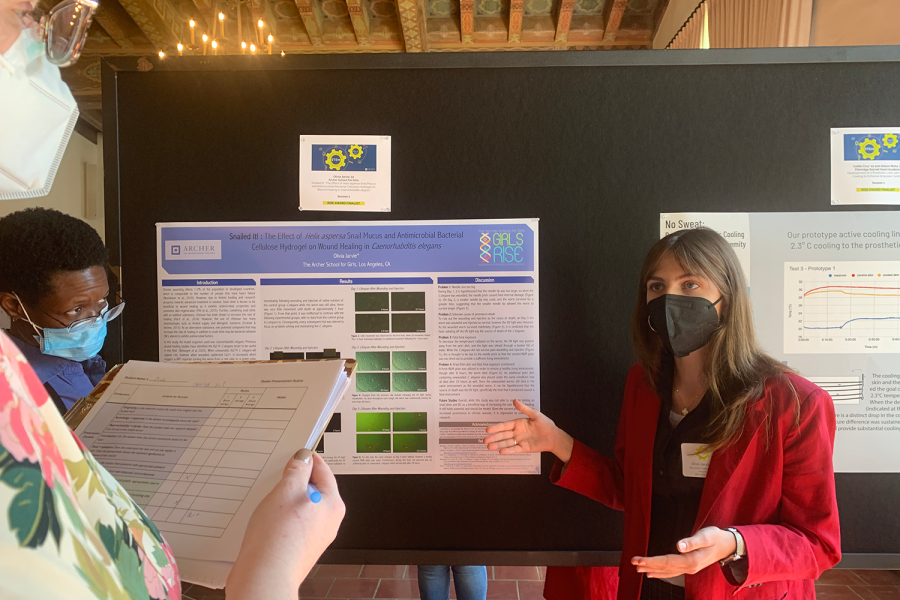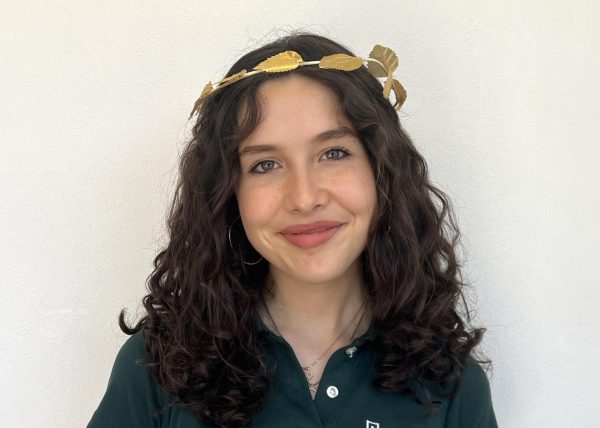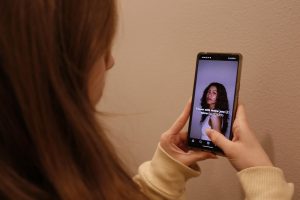Worms healing wounds, devices fighting fires: STEM Symposium features Los Angeles student scientists
Photo credit: Lucia Williams
Senior Olivia Jarvie presents her project about the effects of snail slime on chronic wound healing, while judges Max Ezin and Lynn Bresnahan grade her presentation and research skills. Student scientists in Archer’s research classes showcased their yearlong projects at the symposium.
June 4, 2022
A scientist in Los Angeles is researching a cure for Parkinson’s disease using fruit flies. Another scientist is using Bluetooth to cure separation anxiety in dogs. One created a model ocean to test if fish get caught in Boyan Slat’s Ocean System. These scientists are among the upper schoolers who presented at Archer’s annual Student STEM Symposium.
STEM enthusiasts gathered in the dining hall May 14 to listen to students’ projects in fields including biochemistry, engineering and environmental science. The symposium featured 30 Archer student presenters and 26 student presenters from other high schools in Los Angeles. Archer InvenTeam’s head of app programming and design Maia Alvarez (’24) said she was inspired by the scientists’ commitment to solving a problem.
“We’re going about our own lives at school, and students are giving 110% to find answers about things we hadn’t been thinking about and should be more curious about,” Alvarez said.
The event started with two gallery-walk poster sessions in the dining hall followed by three 15-minute presentation sessions to dive deeper into specific projects.
Archer hosted Max Ezin, cardiac biologist at Loyola-Marymount University, and Lynn Bresnahan, senior operations manager at toilet paper company Who Gives a Crap, to grant awards. Archer Alumni Brooklin Cohen, who is working on the Mars 2020 perseverance rover at the Jet Propulsion Laboratory, also judged the presenters. Archer science teacher and STEM coordinator Jerilyn Neshek organized the symposium.
“The research process is real-world, and things don’t go as you plan,” Neshek said. “Bess Frierson’s internship at a kelp farm inspired her to research the best way to produce kelp in the middle school science fair FLX block. She then designed a device in her engineering class that would improve the system. She saw a problem in the world, and she wanted to solve it.”
Senior Evan Bowman received the Archer Rise Award, an award that honors research projects that face scientific challenges. She tested two traditional Chinese medicines made of turmeric and peonies on chicken embryos. She hypothesized they would reverse the effects of phthalates and hopes to prevent the fibroid tumors caused by the chemical, which about 77% of women in the U.S. are diagnosed with.
“It’s invigorating to be able to dive into a topic you’re passionate about and find questions you might be able to answer,” Bowman said. “The awards ceremony gave so much pride to myself and my research class, and all of the work we put in was recognized.”
Senior Noa Wallock won the Engineering Award for designing, building and testing a device for sexual assault survivors to administer rape kit tests themselves. She said this decreases the re-traumatization that comes with a doctor’s intimate testing.
“Survivors spoke out during COVID, and I have personal connections with people who have gone through terrible things,” Wallock said. “There’s a global backlog of rape kits right now, so people’s evidence is sitting in a fridge for years and not getting processed. There’s nothing on the market right now, but we should be focusing on helping these people.”
Senior Olivia Jarvie won the Scientific Research Award for her project on the effectiveness of bacterial cellulose and snail slime on chronic wound healing. She tested it on microscopic worms called C.elegans. She said she overcame many obstacles during experimentation, including test worms dying after an hour.
“In every research project and scientific study, something is bound to go wrong. Delving into the problem was fascinating to me, and it was fun, although challenging,” Jarvie said. “There was no STEM symposium last year, so this year was nerve-wracking.”
The Archer InvenTeam presented their Lemelson-MIT grant-winning invention, Hydra, to a tightly-packed room. Hydra is an automatic sprinkler system that uses infrared technology to detect and extinguish embers from roofs in a wildfire. The middle and upper school members displayed Hydra’s progress since 2019 and spoke about aspirations for larger-scale testing.
Keynote speaker Dr. Patricia Gordon presented in the library about her journey in the medical field. After practicing oncology in Beverly Hills for 20 years, she took a mission trip with her coworkers to Senegal to assist in a clinic. Astonished by the impact of cervical cancer in developing countries, she started a nonprofit called Cure Cervical Cancer, which has treated 10,474 women in 10 countries.
“It’s fascinating to see the changes in women’s health that she has enacted all over the world,” Jarvie said. “Hearing her whole story — from building up her career, going into college and enacting change as a woman in a male-dominated field — inspires future STEM-focused female leaders.”
Bowman said the journey through her research project gave her valuable experience for the future.
“The STEM Symposium was part of the reason that 11-year-old me chose to come to Archer. I saw the juniors’ and seniors’ research and knew I wanted to be them,” Bowman said. “Archer gave me the resources and support to become a researcher and a well-rounded student. I’m going to Yale next year, and my first task will be asking professors if they need help in their labs with state-of-the-art research.”









